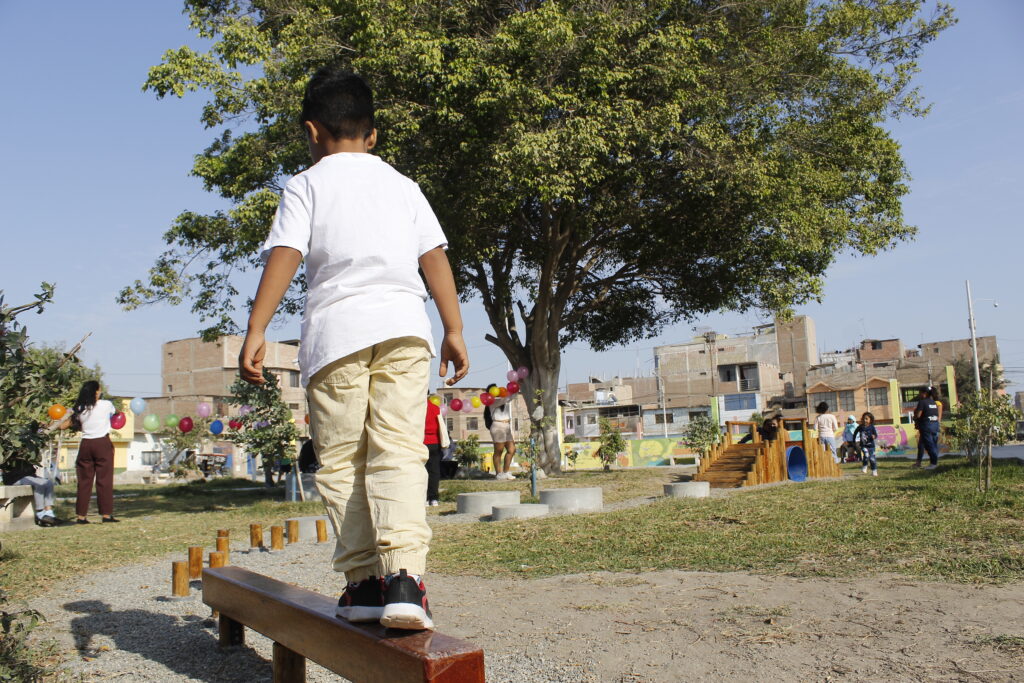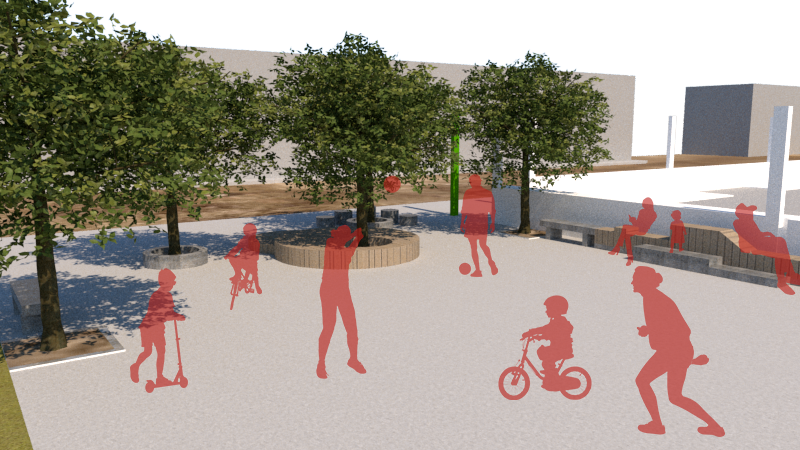
Overview
Location:
Chiclayo, Peru
Organisation:
Arup
Partner organisations:
Ocupa Tu Calle; Peaton Cix; Urrunaga community group
Year:
2021- 2022
Scale of proximity:
Neighbourhood
Target beneficiaries:
Children 0-5; Children 5+; Pregnant women; Caregivers
A child-focused approach to improving public spaces in Peru
Urrunaga is a rapidly developing “young neighborhood” in Chiclayo, Peru, presenting both challenges and opportunities to embed a strategic child-focused approach from the bottom-up.
The ‘Urrunaga Te Cuida’ project aimed to develop an inclusive masterplan for improving public spaces in the neighborhood, with detailed designs developed for a prioritized area around a local school that Arup, as part of the United Kingdom Delivery Team (UKDT), was helping reconstruct. The combined projects aimed to ensure that children could enjoy a safe and stimulating learning and play environment that goes beyond the classroom and into the public realm.
Successful delivery was underpinned by strong collaboration. In 2021, Arup began engaging with local partners Peaton Cix and Ocupa Tu Calle to explore how to build on Urrunaga’s grassroots initiatives, high social capital, and shared ambition to build a more inclusive neighborhood. Together, we developed a strategic approach, using the Proximity of Care framework to improve local areas to better support the needs of young children and caregivers.
Understanding community needs through extensive engagement
We began the project by conducting four capacity building workshops with our partners on the Proximity of Care Framework. From the outset, the framework was used to help us devise context-relevant analysis and engagement strategies with the local community and associations.
During the understanding stage, our partners conducted 7 site visits, 9 interviews, and a diagnosis workshop with the community. From this extensive engagement, it became evident that there was a need for more inclusive spaces for young girls and toddlers, as well as spaces that could provide shade and shelter from the harsh sun in the area. A full analysis was recorded in the form of a baseline report.
Designing with the local community to make sure relevant needs are met
The community was heavily involved from the outset, accompanying the project across all phases of analysis and diagnosis, design and validation, implementation, and evaluation, which were conducted within one and a half years.
The community’s needs and aspirations were reflected in the masterplan for the area, and they heavily influenced the initiatives included and the prioritization of improvements. As such, it was agreed to start with two pilot interventions: playful circuits and spaces of tree shading and shelter, with sought to provide gathering spaces adapted to people’s various needs.

Working with the community and a local artist to revitalise a mural. Photo credit: Arup
The first intervention included:
- ‘Play circuit’ – composed by a long wooden walkway and wooden sticks (for children to balance and then jump)
- Rounded concrete platforms – where children could sit or jump between (distance would make it a fun challenge for them to try to reach the other platform by jumping)
- Concrete benchs with different heights and ramp transitions for children of all sizes to sit and play comfortably. This bench was strategically located under a tree to ensure it was a comfortable space for caregivers accompanying children at the park.
The second intervention was focused on the concrete area next to the football pitch. This is an area where more community events would happen. The purpose of these elements was therefore focused around providing seating, shade, and platforms to be used for the community at gatherings, such as:
- ‘Shade and shelter’: Rounded wooden platform with young trees in the middle.
- More rounded concrete platforms for sitting and playing on.
- Another concrete bench and platforms around it for seating and playing.

Play spaces and seating areas were designed around trees for shading, and active public spaces such as a local football pitch. Photo credit: Ocupa tu Calle and Peaton Cix
Play spaces were also provided outside the main football pitch to support girls in reclaiming space through play, as they were normally excluded from activities happening on the main pitch. The success of the initial interventions helped refine the second phase, which included more shade and flexible play elements, but with a focus on creating spaces where children and caregivers could gather and reclaiming more central spaces in the park.
A hand-over report, which recorded our journey, maintenance guidelines, and potential next steps, was provided to the community. This document, along with the wider masterplan, aimed to serve as tools to approach the municipality and other stakeholders to make the case for further investment in urban childhood interventions.
Implementing and influencing to place children’s wellbeing at the centre of design decisions

Implementing simple but playful elements into public spaces to create space for children and caregivers. Photo credit: Arup
The Proximity of Care guide encourages and provides tools to engage with stakeholders throughout the design process. This project is evidence of how involving them from the outset, collectively analyzing their area under a structured framework, and co-designing a plan of action has led to the local ownership of the final outputs. The community has committed to maintaining the assets and is already exploring ways to support the implementation of further interventions. This means that the impact is being realized as change does not stop with this project but is rather an ongoing process that will continue to develop into the future.
Working together with the local community allowed for an even bigger impact. It created healthier environments for the whole community, increased representation and inclusivity in public spaces, and increased social capital from an even more engaged community.
“I commit myself to supporting my fellow neighbors in caring for the park” – Urrunaga Neighbor.
The Proximity of Care framework was a key element in helping us unlock these outcomes. By putting the well-being of children at the center, we achieved a common ground to open up conversations and foster collaboration between the different local stakeholders, including neighbors, local associations, police, and the municipality. Our partners were key in enabling this by organizing workshops for discussion and collaboration, and by having regular contact with the various stakeholders. At the end of the process, community trust was truly visible.
The robust assessment analysis and consistent design process make this a process that can be replicated in other neighborhoods that also have high social capital but could benefit from steering and integrating bottom-up actions for better outcomes.
Three lessons learnt on applying the Proximity of Care approach to overcome urban design challenges
From our perspective, a key challenge will always be managing and steering all the energy from the various actors and articulating views from stakeholders with those from the local authority. Some of the key lessons we can share are:
- Inclusive and representative stakeholder engagement is key. This means going the extra mile to reach as many stakeholders as possible and understanding existing initiatives and any concerns from those groups that are usually easy to ignore. Taking a proactive approach to inclusion is crucial.
- Find local champions – partners and stakeholders who will have the time and desire to truly commit to the project, driving momentum and supporting on-the-ground activities.
- Use outcomes language to remind people why we are doing this. The Proximity of Care guide is a great tool to support this as it provides a clear child and caregiver-centered approach, which we found really brings people together.
Links and sources:
https://www.arup.com/projects/design-guide-for-early-childhood